Understanding restaurant fire safety regulations and fire protection systems protects your property, employees, and customers — and the health of your business
So, you own a restaurant or you’re thinking of starting one? It’s an in-demand business – 39% of adults would like to eat at restaurants more often, and 51% of diners eat out more than once a week, in an industry that does nearly $800 billion in sales annually.
John Taffer, the host of the hit show Bar Rescue and author of Raise the Bar: An Action-Based Method for Maximum Customer Reactions, states that it’s “a growth industry and there are plenty of opportunities to make money and create the legacy of smiles if you do it right.” And along with the “right” stuff of smart menu creation, staffing, and restaurant design is making sure you have the appropriate fire protection and life safety measures in place — to protect patrons and property and avoid costly restaurant closures and fire safety violations.
NFPA 101: Life Safety Code is a model code that provides the requirements for fire protection and life safety based on a building’s occupancy type and occupant load. A medium-to-large-sized restaurant holding 50 or more people is defined as an “assembly occupancy” and must meet the requirements in chapters 12 (new assembly occupancies) and 13 (existing assembly occupancies).
From the 2022 edition of NFPA 101
6.1.2.1* Definition — Assembly Occupancy. An occupancy (1) used for a gathering of 50 or more persons for deliberation, worship, entertainment, eating, drinking, amusement, awaiting transportation, or similar uses …
Smaller restaurants having an occupant load of “fewer than 50 persons,” however, are classified as mercantile occupancies (A.6.1.10.1), which are generally defined as “An occupancy used for the display and sale of merchandise” (6.1.10.1). Mercantile occupancies must meet lesser fire protection requirements than assembly occupancies, specified in chapters 36 (new) and 37 (existing).
The primary difference between assembly and mercantile occupancies are the limitations and allowances for the “means of egress” — in plain speak, the ways that are available to exit the property in an emergency. There are no requirements for fire sprinklers or fire alarms in smaller spaces. Larger spaces with a much bigger occupant load, however, are required to have these systems.
To determine what fire protection features are required, establish the total occupant load:
From the 2022 edition of NFPA 101
3.3.172.2 Occupant Load. The total number of persons that might occupy a building or portion thereof at any one time.
Occupant loads are determined by dividing the available floor area square footage by the occupant load factors shown in Table 7.3.1.2 of NFPA 101:
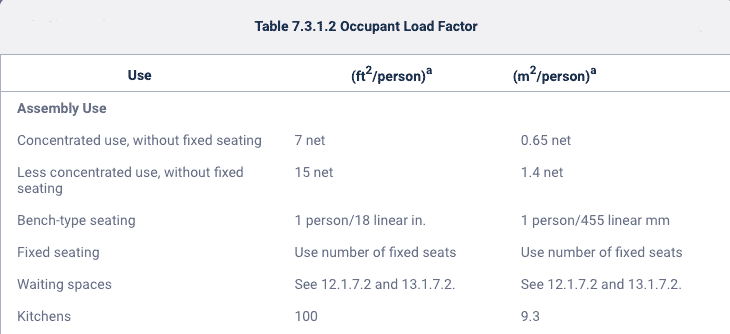
This table shows five areas that specifically pertain to restaurant occupant loads. To determine the occupant load, you measure the square footage of a given area and divide it by the allowed square feet per person. For example, a 500-square-foot kitchen would have an occupant load of 5 people, given the maximum of 100 square feet per person listed in the table above. Each type of area in the building should be calculated individually based on the numbers in the above table and then added up. In the end, you will have the total occupant load for the restaurant space.
The following occupant load limitations specific to larger assembly occupancies must be also used when they apply:
From the 2022 edition of NFPA 101
12.1.7.1.1 (new)/13.1.7.1.1 (existing) In areas not in excess of 10,000 ft2 (930 m2), the occupant load shall not exceed one person in 5 ft2 (0.46 m2).
12.1.7.1.2 (new)/13.1.7.1.2 (existing) In areas in excess of 10,000 ft2 (930 m2), the occupant load shall not exceed one person in 7 ft2 (0.65 m2).
Four types of restaurant fire protection systems
In general, very large restaurants will require all of these elements of fire protection, whereas smaller ones will only need the last two:
- A fire sprinkler system
- A fire alarm
- Cooking equipment protection
- Special protection for any hazardous areas
1. Fire sprinkler systems in restaurants
A fire sprinkler system is required in all establishments that are classified as dance halls, discotheques, or nightclubs, or when the total occupant load exceeds 300 persons. Many smaller restaurants still install sprinklers, however, as common wet systems are fairly affordable and lead to vastly greater fire safety, plus discounts on insurance. Any structures that use automatic fire sprinkler systems must install them in accordance with NFPA 13: Standard for the Installation of Sprinkler Systems.
If your building requires a fire sprinkler system, the system must also be properly maintained to work properly and pass fire inspections. NFPA 25: Standard for the Inspection, Testing, and Maintenance of Water-Based Fire Protection Systems outlines the requirements for water-based systems.
Many potential code violations are illustrated in the two-part QRFS article series: “NFPA 25: The 10 Most Common Fire Safety System Compliance Issues and How to Avoid Them.”
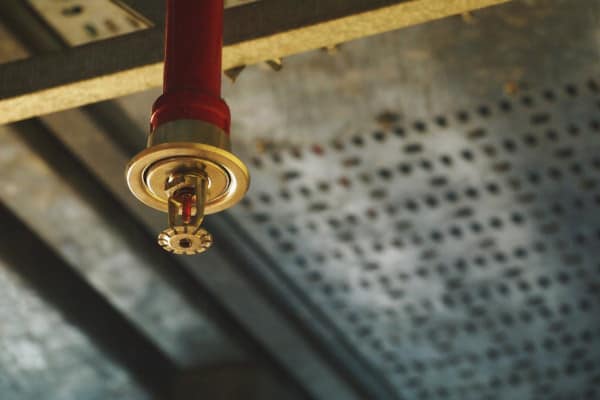
2. Fire alarm
A complete fire alarm system is also required for all assembly occupancies that have an occupant load of 300 or greater. Alarm systems must be installed in accordance with the following NFPA standards:
● NFPA 70: National Electrical Code
● NFPA 72: National Fire Alarm and Signaling Code
The fire alarm signals must be transmitted to a location that is constantly attended while the building is occupied. If the provision of a “constantly attended location” is impractical, the local fire authority having jurisdiction (AHJ) can require the system to be monitored by an off-site supervising station.
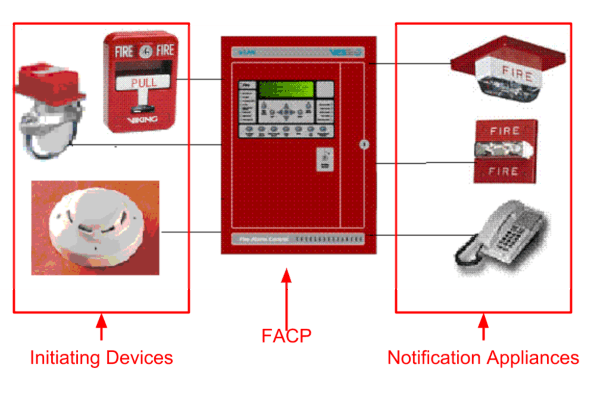
A fire alarm panel can, at first glance, seem intimidating. Demystify a panel and its operations by reading this blog post: “What is a Fire Panel and How Does It Work?”
3. Cooking equipment protection
All cooking equipment used in a commercial application is required to have specific protection. NFPA 96: Standard for Ventilation Control and Fire Protection of Commercial Cooking Operations outlines the full requirements for fire protection. The minimum requirements include a hood and duct system with cooking equipment placed beneath it. A fire extinguishing system must be installed within the hood, and an exhaust duct system must remove flammable, grease-laden vapors.
From the 2021 edition of NFPA 96
10.1.1 Fire-extinguishing equipment for the protection of grease removal devices, hood exhaust plenums, and exhaust duct systems shall be provided.
10.1.2* Cooking equipment that produces grease-laden vapors and that might be a source of ignition of grease in the hood, grease removal device, or duct shall be protected by fire-extinguishing equipment.
10.1.3 Fume incinerators, thermal recovery units, air pollution control devices, or other devices installed in the exhaust duct, shall be protected by an automatic fire-extinguishing system.
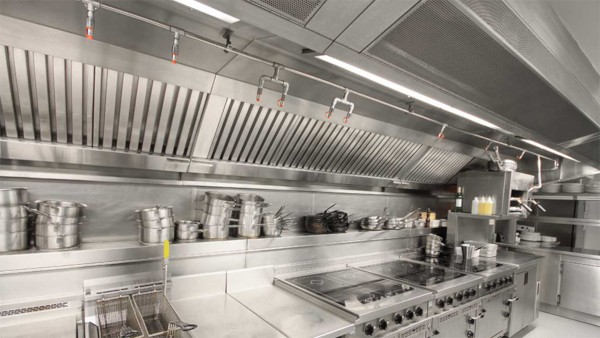
4. Special protections for hazardous areas
NFPA 101: Life Safety Code defines several areas of structures as hazardous. These locations are required to be separated from the rest of the building by a minimum of one-hour fire-resistance-rated construction or protected by an automatic fire extinguishing system. Hazardous areas are rooms or other areas that include:
● Boilers and furnaces
● Refrigeration machinery (other than domestic)
● Electric transformers
● Service equipment subject to explosion
● Storage of combustible supplies
● Storage of hazardous materials or flammable or combustible liquids
Other particularly hazardous areas such as laundries, maintenance shops, rooms used for the processing of hazardous materials, and spaces used for the processing of flammable or combustible liquids must be separated by a minimum of one-hour fire-resistance construction and an automatic fire extinguishing system. These spaces are less common in restaurants — but if any apply, you must comply with this extra protection standard.
Fire safety is essential in a successful restaurant
Most restaurants close during their first year of operation and the 70% that make it past year one usually close within three to five years. The 90% of restaurants in operation past five years will last for at least 10 years, however. Given these challenges, incorrectly installed fire protection or life safety systems — or a lack of them altogether — shouldn’t be why a restaurant fails.
As Bar Rescue host Taffer cautions owners, “You have a serious responsibility to provide a safe space. The public places its trust in establishments and that trust should be honored.”
Providing and properly maintaining appropriate fire protection systems and complying with restaurant fire safety regulations protect property and patrons in an emergency and keep you from running into expensive or even business-killing code violations.
To learn more about the top fire code violations cited by local government inspectors, read this blog.
If you need to replace fire sprinklers and you aren’t sure what you need, read this comprehensive guide.
And if you are looking to buy fire protection system components, browse QRFS’s wide selection or contact us at 888-361-6662 or support@qrfs.com with any questions.
This blog was originally posted at QRFS.com/blog. If this article helped you, check us out at Facebook.com/QuickResponseFireSupply or on Twitter @QuickResponseFS.


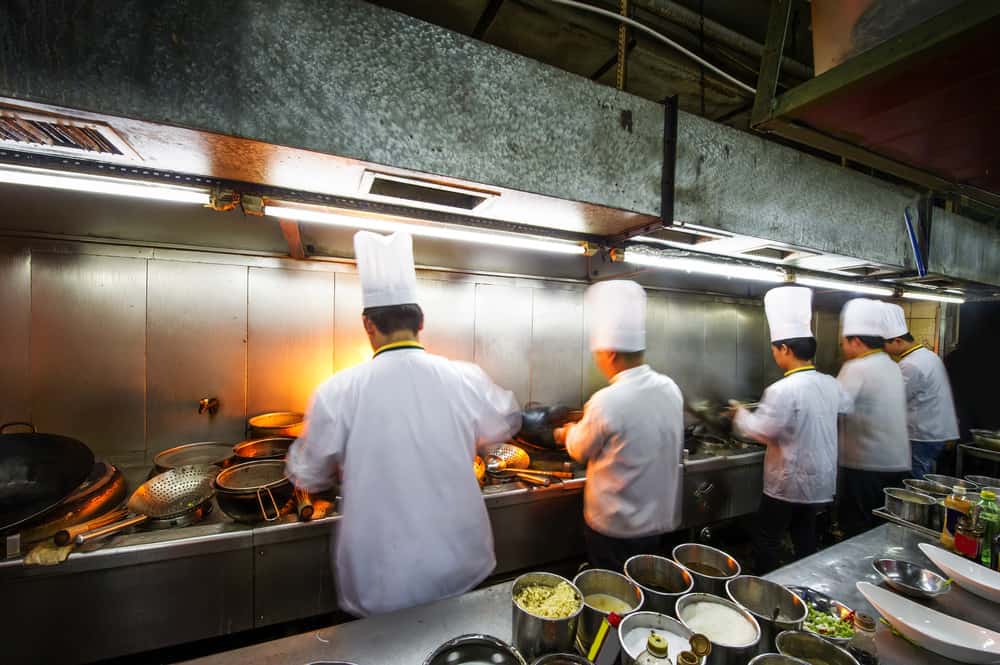
I love the idea of getting a fire system that constantly monitors the building even when people aren’t there. My brother has an office that he wants to keep secure when he isn’t there because he is worried about water leaks and fires. It would be great if he could find a service like this so that he can just monitor everything from his own home.
Thanks for explaining that fire sprinklers and other fire safety equipment need to be inspected regularly. I hope that all restaurants and businesses follow through on this in order to keep their clients safe. I don’t want to go inside a building that hasn’t passed a fire safety inspection.
Hi.
we have outdoor restaurant roof & side enclosure is glass (openable) beside the hotel apartment building.
Can we use the escape route from the restaurant through the existing building there is door in between and the client select this to controlling the guests
Or it should have another escape route direct to outside.
Please advise with reference from NFPA
Basem — For code questions like this, you can try our Ask a Fire Pro service. Click the link to submit your question with some information about your building, and a fire protection professional will provide an answer based on best practices, standards, and codes. Our pros include AHJs, contractors, engineers, and code experts with 150+ years of combined experience!
I have opened 4 pizza places in manatee county Florida .
They recently give me problem about not having the hood system but just the exhaust ventilation above the roof.
So I wanna ask you; Is a pizza oven which is the only and repeat the only equipment in a 600 sq ft non seating occupancy Requires a hood system not producing a large quantity of cheese or vapor. And is there any specification sheets we can prove the fire department? I live in manatee county thanks.
Marina — Overall, the rule is that any cooking equipment in a commercial application must be protected, and there are hood systems for pizza ovens. If you would like to get a well-researched answer from a fire protection professional who looks at model and local codes, you can try our Ask a Fire Pro service.
You can click the link to submit your first question with some information about your building, and a fire protection professional will provide an answer based on best practices, standards, and codes. Our pros include AHJs, contractors, engineers, and code experts with 150+ years of combined experience!
Can you open business if you failed fire insection to family and friends
Theresa — We can’t comment authoritatively; you should ask the local authority having jurisdiction (fire inspector) about your specific situation. However, if a failed fire inspection results in a building shutdown, it means the building is shut down. If a failed fire inspection results in a notice to fix something ASAP but the building is not shut down, that is a different situation.
Hi, I have a coffee shop and I will like to know if I need a hood system? The space is 670sqft and I will only have an electric griddle.
Alex — We can’t provide specific code compliannce guidance in this forum, but you can check out Chapter 50 of the Florida Fire Prevention Code (as you seem to be in FL) or contact the Florida State Fire Marshal’s Office or your local authorities and run your scenario by them (it may be easier and faster). Thanks for reading!